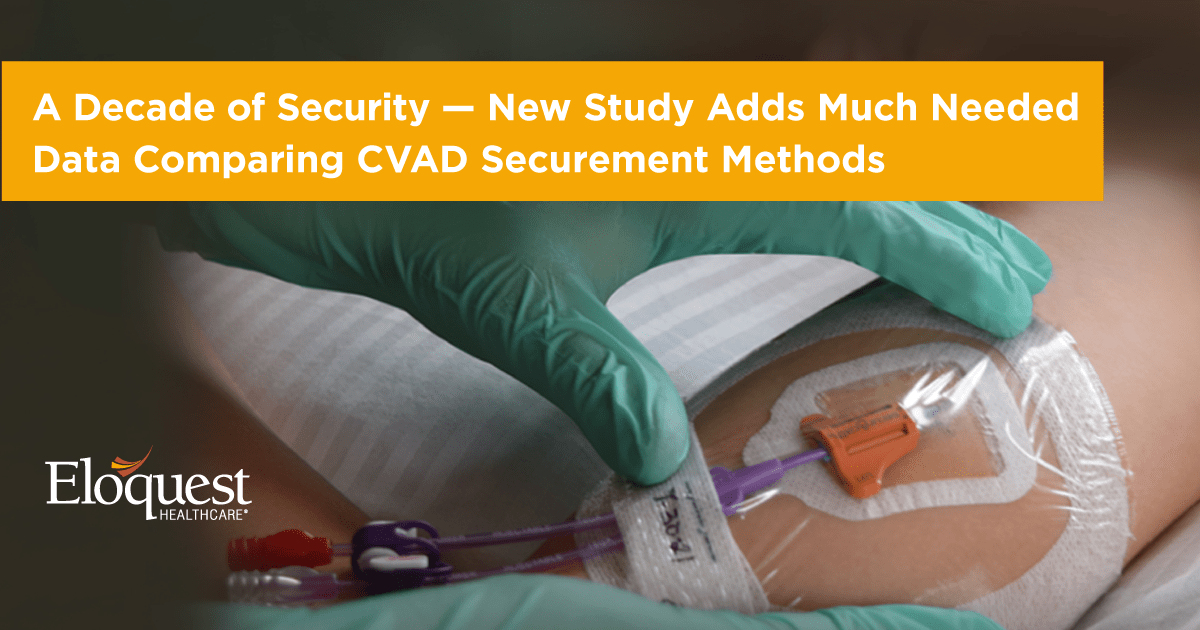
A Decade of Security - New Study Adds Much Needed Data Comparing CVAD Securement Methods
Importance of PICC Securement
Patients who require central venous access devices (CVAD) to monitor laboratory values and receive cancer treatments, blood transfusions or other drugs may receive a peripherally inserted central catheter (PICC). Best practices have been established for proper PICC placement, including the use of ultrasound guidance, tip terminating technology and sterile barriers. Yet when it comes to PICC securement, it is often tradition and convenience – not evidence-based research – that determine the type of securement used to keep these catheters in place.
This lack of evidence-based best practices is surprising given that proper securement is an important component in the care and maintenance of CVADs. It ensures device integrity, minimizes catheter movement at the insertion site, and prevents catheter dislodgement. Poor securement can negatively impact the course of treatment and lead to infection. This can result in prolonged hospital stays, during which additional interventions and/or VAD replacement may be needed.
“Uninterrupted central venous access is often critical to sustaining life for many patients. Proper placement is vital, but insertion of the CVAD is only the first step,” said study co-author Michelle L. Hawes, RN, DNP, CRNI, VA-BC, ACRP-CP. “Securement is step two in the process, and it can last from day one to day 1,282, as in our study – which means keeping the CVAD tip securely in place for the duration of therapy is just as important as dwelling the tip in the optimal position during insertion.”
Types of Securement
The goal of any securement method is to ensure continued device function and avoid complications associated with motion, such as phlebitis, thrombosis, and infection. Securement methods should not interfere with routine assessment and monitoring of the access site nor should they impede the delivery of therapy.
Options for catheter securement typically fall into 3 categories:

Given the importance of proper securement and its potential impact on patient care, there has been surprisingly little research to compare the safety and efficacy of various securement methods.
Fortunately, this is beginning to change.
A Decade of Security
A landmark study was recently presented at the 2022 World Congress on Vascular Access (WoCoVA) in Athens, Greece. The study compared outcomes for migration or dislodgement and reaching the end of catheter need for patients with two different types of securement – an adhesive securement device (ASD) and a subcutaneous anchor securement system (SASS).
With over 9,200 patients and more than a decade of assessment – representing more than a million catheter days – the study clearly demonstrated the SASS’s superiority in reducing the incidence of migration and dislodgement.
Study Highlights:
- For ASD-secured PICCs, migration and dislodgement caused premature removal of 12% of catheters, compared to just 0.4% of SASS-secured PICCs.
- The probability of reaching the end of need with one PICC for patients using an ASD was 68% at two years, and for patients with the SASS was over 95% at two years
“In vascular access, one of the main goals is to reach the end of need with one catheter, and the sheer volume of data we accumulated over 10 years clearly demonstrates that SASS is the optimal securement method to accomplish this goal,” said Hawes
Mounting Evidence for SASS - The Future of CVAD Securement?
This study adds to a growing body of research showing clear benefits with SASS compared to other securement methods:
- A recently published systematic review of CVAD securement literature suggests that SASS is more effective at keeping central catheters in place, compared to either ASD or suture-based securement
- A retrospective study found that a single catheter secured with SASS lasted throughout the entire length of need in 98% of cases, while 32% of ASD-secured catheters needed to be replaced.
- A 2020 study showed that SecurAcath also significantly reduced the risk of bloodstream infections compared to adhesive securement device methods for PICCs.
Catheter migration and dislodgement have a tremendous impact on patient outcomes, as well as healthcare costs. While more research is needed, the evidence increasingly suggests that SASS is superior to other securement methods – and may, in fact, be the future of CVAD securement.
“The key to understanding the issue is to emphasize that securement failure is not an inevitable event but rather an adverse event that requires reporting,” said Hawes.
Eloquest Healthcare is committed to providing solutions that can help improve catheter securement and decrease complications while reducing unnecessary costs. For more information about SASS, please call 1‐877‐433‐7626 or complete this form.
Eloquest Healthcare, Inc. can partner with your institution to facilitate a Vascular Access Device Site Assessment to determine the state of vascular access device & dressing securement for patients in your facility, while providing you and your team with information on your facility’s infection risk, nurse efficiency, and potential product waste. Click here to request a Vascular Access Device Site Assessment today!








